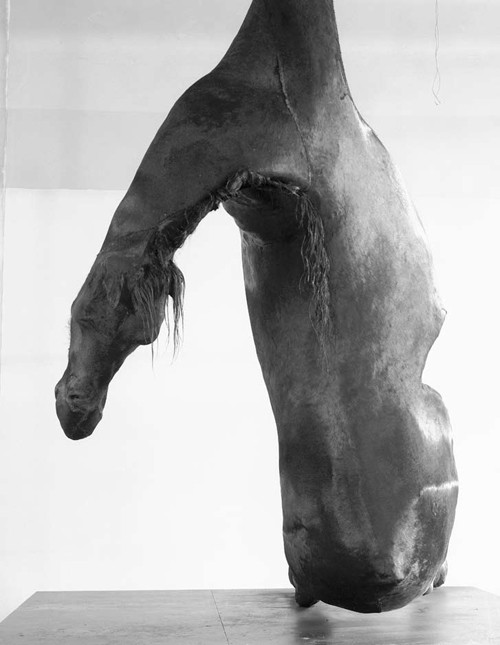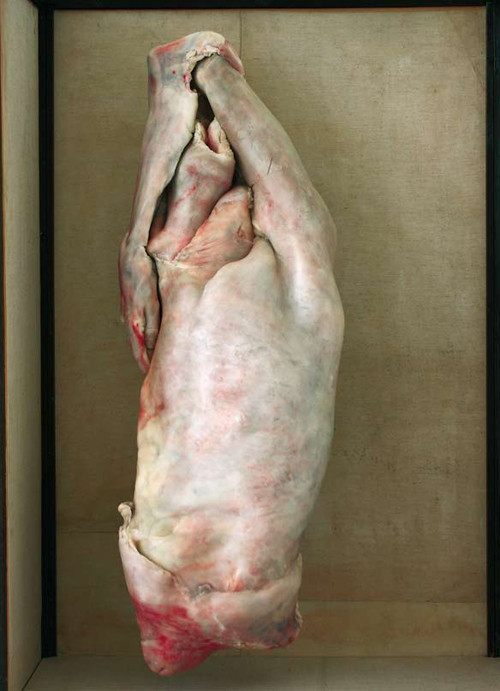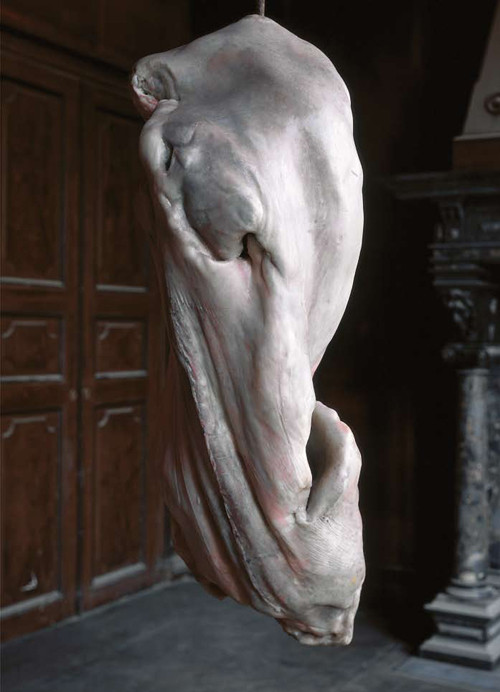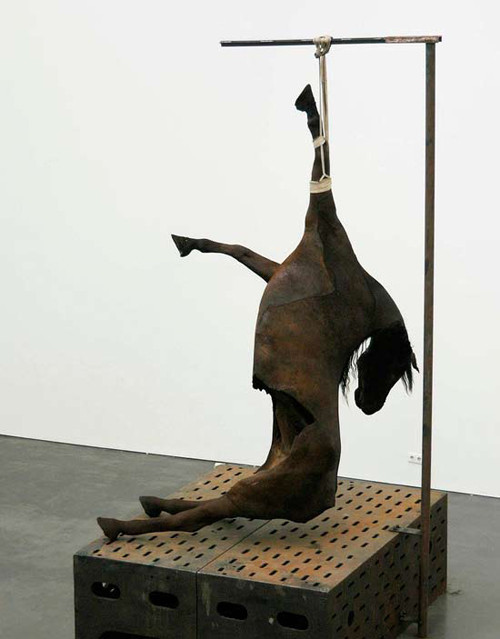Berlinde de Bruyckere
Published: September, 2010, ZOO MAGAZINE #29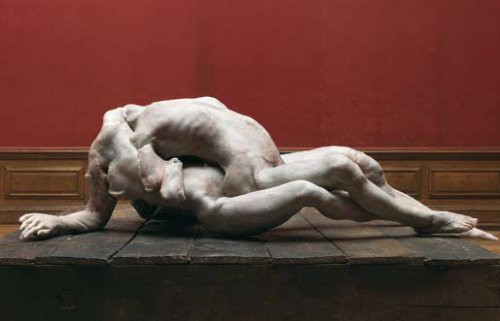
Berlinde De Bruyckere is one of the star artists in the worldly firmament. In her huge studio in Ghent, a building that was once a Catholic school for boys, she shows me some of her awe-inspiring works. The austere classrooms have been transformed into working studios full of sculptures, objects, photos and books. The headmaster’s home has been turned into a residence for De Bruyckere and her family. We look at powerful photos of an athletic young man bound to a pile and frozen in several convoluted positions.
Berlinde De Bruyckere: For my new work—a statue that refers to the figure of Saint Sebastian—I made a photo series of this naked man whom I bound to an old column that I found at the train station. Saint Sebastian is a strong, old iconic image; an ambiguous figure that seduces but is dying at the same time; someone who defies the beauty of his body as if he wanted to transform it into a higher level; an image full of homoerotic connotations; an image that, in my opinion, we can also see today in fashion magazines, the news, and around us. When I look at old paintings of Saint Sebastian, I have the impression that despite the arrows that stick into his body, he is untouchable and feels no pain. I imagine that the arrows are the gaze of the painter; they cannot resist the beauty of the saint so the only possibility is to kill him. As in the amazing film Sebastiane by Derek Jarman, the unattainable beauty must be destroyed.
Marta Gnyp: Your knowledge of art history is very prominent in your oeuvre. Do you intentionally want to be in a dialogue with the Old Masters?
BDB: I will have a museum show in Halle next year that will be a confrontation between the works of Lucas Cranach and Pasolini and my own. Cranach has fascinated me for a long time because of his formal language and his approach towards the body: his elongated figures, strange proportions, the black background that releases the figures from their dependency on the context—all these aspects have influenced my way of thinking. His subjects were morbid and cruel but there has been always the ambivalence and ambiguity between how the form fits into the subject: there is the death but no blood; there is a sword that kills, but at the same time, the gentle touch of the victim. In a similar way, I feel a strong connection with the stress on the body and its sophisticated, visual language. A combination of a sense of beauty and reality is also a departure point for Pasolini: he is able to make a real angel from his actress. But to achieve this effect, he will endlessly repeat each scene and will be involved in setting up the image right to the tiniest of details. I see similarities in my approach. I let my models undergo a metamorphosis by disclosing to them my ideas about the final image and its emotional connotations, so they can dig into themselves and search for these particular emotions. I show my drawings to the models in order to explain what I want and ask them to translate it into an image. During a photo session, I request the model to take a specific position. Their bodily and mental translations are highly personal but able to express my original concept at the same time. Perhaps it’s because while selecting my models, I intuitively sense who can best transform his emotional depth from my ideas.
MG: You often seem to work intuitively. What does intuition mean for you?
BDB: It means to trust what you feel is intuition. When I’m in my studio, I’m not searching what to do; something is already there. That feeling has to be translated into an idea and later into an image. Listen to what there is and what can grow, to give it the freedom and trust to let it happen. Don’t be content with just the first layer. Intuition is something I learn to trust in the moments I doubt about my work.
MG: Coming back to your intuitive choice of models, do they understand what you ask from them?
BDB: It is very important for me that they realize that the original idea and the final work are not the same, that perhaps they will not recognize themselves in the image. I want them to be warned that their bodies will finally not be theirs. One of the models refused his body model to be used after he saw what would be the end result. I can imagine such a reaction— the object starts its independent, visible life after he leaves my studio; it becomes a fetish.
MG: You cannot transform only the body. You need to change your mental attitude first.
BDB: Exactly.
MG: In many of your works, the body is opened by a wound. Does the wound have a special meaning for you?
BDB: The wound is a sign of being, a hole that makes you aware that the body has an inside. Through the wound, our inner side can be visible to the outside world, which is an essential existential experience. Simone Weil once said, “Out of the wound the wings can grow.” For me, the wound is a sign of change, a gate to another sphere, to a new life—if we think about it, the vagina is a wound—to another state of consciousness, because feeling pain—obviously depending on the intensity of the pain—can make you forget about thinking and reduce you to a flesh experience. At the same time, if speaking in religious terms, this experience means a stage of transcendence. I was inspired by the way Pasolini and Cranach show wounds, showing sexual, physical and bodily fascination at the same time.
MG: This physical aspect, the body and flesh, dominates your oeuvre. I read that your father was a butcher. Did this influence your attitude towards the flesh and body? You must have seen many dead animals and meat as a child.
BDB: I regularly saw big and strong men in white aprons carrying dead animals. I was never afraid of them. I have never felt revulsion for death or anatomy or blood. I realize that those memories play a big role in my unconsciousness, but consciously, the connection is not that direct. I work with dead animals; my point of departure is, for example, a dead horse, but only to transcend it into an image that can heal, that can show many aspects of life, love and lust in their clarity and purity.
MG: Several times when I have described your work as ‘beautiful,’ I was told that they are not so much beautiful but disturbing and moving—the beauty and the sublime.
BDB: For me, both categories are important and applicable. In a sublime experience, there are magnificent moments. This is not only about fear and dread, but there is also sheer beauty. These emotions I try to show in my work and to provoke a discussion about these two sides. For example, the emotion of the Pieta is in essence very sad, but thanks to its pictorial quality, vulnerability, and the apparent fragility of the material, it can appeal to other feelings: softness against the harshness of the world. My objects are malformed but they give you the feeling of beauty.
MG: Where does your idea of man come from? (Fragmented, malformed, distorted?)
BDB: Since the beginning of the 90s, I have been working with the human anatomy: firstly, with women covered by blankets where only parts of their feet were visible. Soon after, I sewed objects together: various body parts were literally sewn together to form a new man. Human beings are not one piece. We are made out of various fragments, which all together form what we call a unity; the fragments, the memories that are important now are of no importance tomorrow and perhaps will exist only in our memory. Our curves are liquid and the totality very complex. I like to work from the reality of the body because I know it very well. Taking the body as the departure point, I can refer to universal themes and put the body on a level with mankind. In my work, I try to express doubt, perhaps because of my aversion to so-called certainties that, in my opinion, are no longer applicable to our times. We are searching for rules and habits to survive, but we keep on doubting.
MG: Have you ever used yourself as a model?
BDB: Never. But at this very moment, I’m in the process of making a self-portrait. It refers slightly to my favorite male portrait, Christ Crowned with Thorns, painted by the 15th century painter Antonello Da Messina, which I try to see every time I’m in New York. What is so interesting is the open mouth: the man wants to express something but his expression is immediately suppressed. I can recognize myself in this attitude. My objects are very extroverted, but they are not shouting. I want to make a self-portrait as a man-like horse torso—he looks away with a half-open mouth, a bated but present shout.
MG: Is this how you experience the meaning of your art in the world?
BDB: If I agree, I would immediately be called a moralist. But often when I see exhibitions by other artists, I find my own art oldfashioned. Recently, I visited the biennale in Gwangju, whose motto was ‘10,000 lives,’ an old Korean poem. The idea of 10,000 lives shows that a human’s singular life is very limited—that it poses no urgency in the world within a bigger context. My personal story is only important for myself, but if I can touch something that is universal, then it makes sense. The most touching moments for me is when a viewer can find consolation in my work—that I created an image that has meaning.
MG: How personal are your works?
BDB: They come into being from a personal urgency, a personal question which is relevant for me, not from outside. They are the result of a passionate need to get in contact with the world and community. MG: Why do you never make faces? BDB: Because the communication between the image and the viewer should go through the totality. If you give a sculpture a face, then it becomes immediately the reference point and makes the sculpture too easily accessible. I don’t want to direct the attention to the face because only a total image has meaning.
MG: Speaking of the personal, when did you realize that you wanted to be an artist?
BDB: As a child, you don’t know what an artist is. But if I think of it, actually I was always one. It took a while to put the wish into a convincing form. When I was 16, I went to the academy, but without taking a real decision and without having real faith that I could do it. I had to fight with my parents, who initially agreed to let me attend the academy, but they did not see it as leading to any serious job possibilities. I rented a studio in Ghent and gave drawing lessons to make an income in order not to be independent from my artistic work. This is why I could make what I wanted, and what was not accepted. In the beginning, I was not selling at all, but it was never a problem. I knew I had to continue. I’m still busy with the same themes and forms, geometric and masculine. I made cages, which I still find very strong. There is continuity in my work: the cage works treated the same themes, which are important for me now. The difference is that the iron cage has been replaced by a human body.
MG: Have you never felt the necessity to leave Ghent? You have been living here your whole life.
BDB: This place is great. I have a huge studio that I have been using for 22 years already. This place is full of memories of earlier images and it’s meaningful for me, so I can always find here the peace of mind that I need to work. Besides that, it is very practical: I have a great house, close to nature and to the airport if I want to go abroad. I love to travel and I do it a lot. But to work, I need this place.
MG: Have you seen your works in the homes of collectors? How do your works function in a living space? They require so much attention…
BDB: I sometimes install my own works in collectors’ homes, which can feel strange. Recently, I visited three collectors in the US who have several works made by me. The three were so completely different. In a New York apartment, my work stood in the middle of the living room between Old Masters, African masques and contemporary photography. The owner assured me that the object became a member of the family. It was beautiful to see because each single work has for them a meaning and a reason to be with them. That is for me the ultimate example of how art can live its own life.
